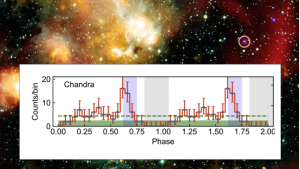
I try to give stories titles that prepare your brain for just what I’m going to talk about. This object… I got nothing.
Astronomers using the Chandra X-Ray Observatory have discovered a long-period radio Transit that also blasts out X-rays. Long Period Radio Transits are mysterious objects that blast radio signals for a few minutes every few tens of minutes. This kind of behavior shouldn’t be associated with a star’s rotation or any of the physics were used to seeing with pulsars, and honestly we’re not sure what they are other than something small like a white dwarf or neutron star, and a lot of people are putting a lot of effort into observing and trying to understand this new class of objects.
One of these objects, ASKAP J1832-0911, bursts into life for about 2 minutes every 44 minutes. Discovered by the Australian Square Kilometer Array Pathfinder radio array, it was found to be less than 150,000 km across and located about 15,000 ly away. While 150,000 km may seem large, it’s tiny for a star; the combination of small size and high energy hints at this being a white dwarf or neutron star.
Because this system is so weird, it earned extra attention — and what astronomers found raised more questions than answers. In observations over the course of 6 months, they saw a factor of 10 decrease in X-ray emission. A search of archival data found no evidence of long-period pulses. It’s possible that this team discovered an object going through a brief period of pulsation.
In a really well-written paper led by Ziteng Want that appears in the journal Nature, this team of nearly 50 researchers systematically examines all the possible explanations that would generally come to mind. It’s not a rotation-powered pulsar; the radio luminosity is just too bright to fit. It’s not an isolated white dwarf – they aren’t bright in X-rays. It sorta resembles a white dwarf binary system that has a white dwarf and a red dwarf; however, the radio emission could only be explained if this were the most magnetised white dwarf known in the galaxy… They go over idea after idea, and nothing quite works.
And that’s awesome – this is something new and a combination of creativity and observations are going to be required to figure out what is going on… this is the kind of mystery astronomers live for, and I look forward to figure out what physics created a solar system capable of blasting out potentially world destroying X-rays and along side bright radio blasts. This is an object to watch.
This work was funded in the US by NASA, the Michigan SpaceGrant Consortium, and the Brinson and Moore Foundations.
